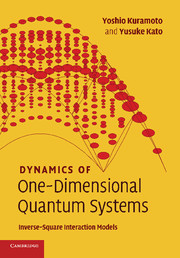9 - SU(K) and supersymmetric Yangians
from Part II - Mathematics related to 1/r2 systems
Published online by Cambridge University Press: 12 January 2010
Summary
We now describe the properties of the SU(>K) chain in more algebraic terms. The relevant symmetry is the SU(K) Yangian, which is usually referred to as Y(slK). On the other hand, the Yangian symmetry of the Sutherland model with spin 1/2 is given by Y(gl2). The difference between Y(slK) and Y(glK) is that the charge degrees of freedom U(1) is absent in Y(slK), while the spin degrees of freedom is included in both Y(slK) and Y(slK). In Section 4.8.3, we have removed the U(1) component by means of the freezing trick, i.e., by taking the infinitely large repulsion parameter. In this chapter we take a more algebraic approach to study Y(slK), which makes the relation between Y(glK) and Y(slK) clearer.
In Section 9.1, we begin with the construction of the SU(K) monodromy matrix as the product form. The commuting property of the Cherednik–Dunkl operators plays a crucial role here. The monodromy matrix is the basic building block of the Yangian algbebra, as discussed in Section 8.2. Because the Hamiltonian of the SU(K) spin chain and the monodromy matrix commute, each eigenstate of the spin chain constitutes a basis for representations of the SU(K) Yangian.
In Section 9.2 and 9.3, we discuss the quantum determinant by comparing it with the ordinary determinant. It is demonstrated in Section 9.4 that the quantum determinant has a scalar nature that leads to a simple evaluation. Because of the scalar nature, however, the quantum determinant cannot distinguish different SU(K) Yangian states.
- Type
- Chapter
- Information
- Dynamics of One-Dimensional Quantum SystemsInverse-Square Interaction Models, pp. 422 - 440Publisher: Cambridge University PressPrint publication year: 2009

